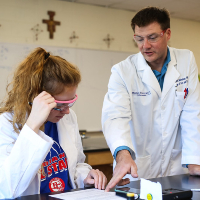by
Jonathan W. Lowery, Ph.D., Assistant Provost for Research and Scholarship | Mar 13, 2024

What comes to mind when you think of the word “helium”? For many, this gas is closely associated with birthday parties and balloon animals. But you might not know that this gas is necessary for a variety of uses including medical imaging and cutting-edge scientific technologies. At Marian University, a steady supply of helium is required for the nuclear magnetic resonance (NMR) core facility, which faculty members and students use to analyze chemical structures in classroom and research settings.
“Access to a high-quality NMR facility is a distinctive feature of our chemistry education,” says Catherine Steding, Ph.D., who serves as the scholar-in-residence for innovation in science, technology, engineering, health professions, and mathematics education. “NMR is a valuable learning tool that few undergraduate students have the opportunity to experience. But at Marian, experiential learning opportunities such as guided work within the NMR facility are an essential part of transforming learners into skilled and inquisitive professionals.”
Helium is a naturally-occurring element found in the Earth’s crust. However, it is a non-renewable resource and there is a finite amount of helium on Earth. Global shortages and instability in helium availability has led many suppliers to prioritize critical services such as those at hospitals and high-volume research institutions. This means that the gas might not only be harder to find and more expensive for your next party, but small-volume buyers such as primarily-undergraduate institutions like Marian could get left out altogether.
“Unstable supply has forced many universities to shut down their NMR spectrometers—sometimes for weeks or months between helium deliveries,” says Chris Nicholson, Ph.D., who is assistant dean of the College of Arts and Sciences, associate professor of chemistry, and director of the NMR core facility. “We are committed to hands-on, real-world education and this technology is too important for us to shutter. So, we got to work on finding innovative solutions to obtaining the helium we need.”
Through industry contacts and creative problem-solving, Dr. Nicholson secured an arrangement for Marian University to join a high-volume buying group so helium can be supplied directly from the NMR manufacturer. Additionally, he spearheaded a grant application to the National Science Foundation’s Major Research Instrumentation Program that, if awarded, will upgrade the NMR core facility with new technology to reduce the amount of helium lost during normal operation. This equipment would help sustain functioning of the NMR core facility for years to come and limit the overall amount of helium used by the institution.
“Not only has Dr. Nicholson’s leadership been crucial to preserving an essential university resource, he has also ensured that students will continue to receive the hands-on experience that characterizes a Marian University education,” says Executive Vice President and Provost Alan Silva, Ph.D. “Additionally, his attention to helping protect a vulnerable natural resource exemplifies our Franciscan sponsorship value of ‘responsible stewardship.’”
For more information about collaborative or commercial research use of the Marian University NMR core facility, email research@marian.edu.
